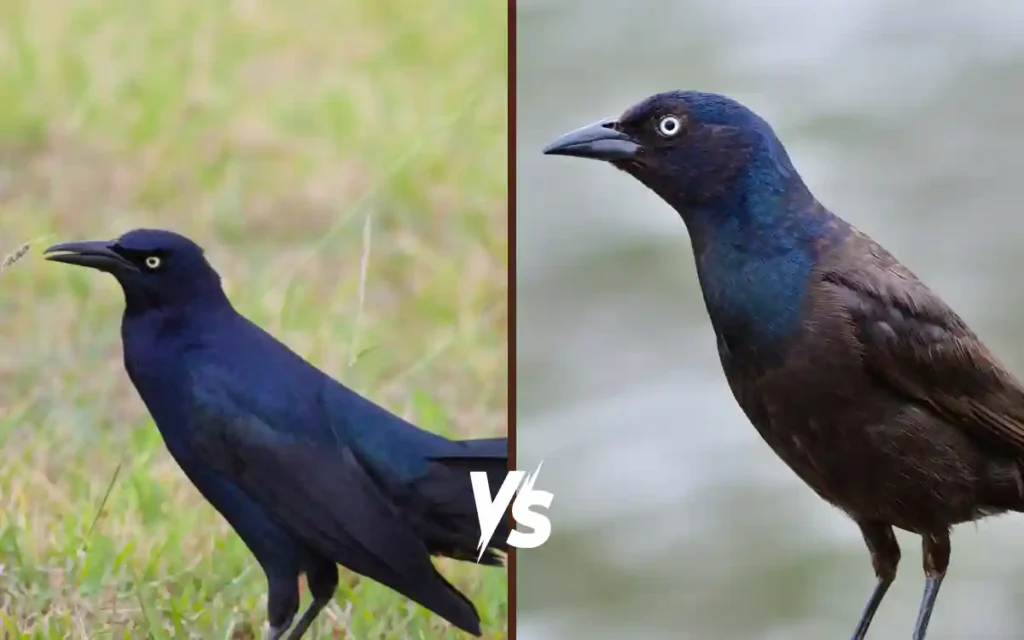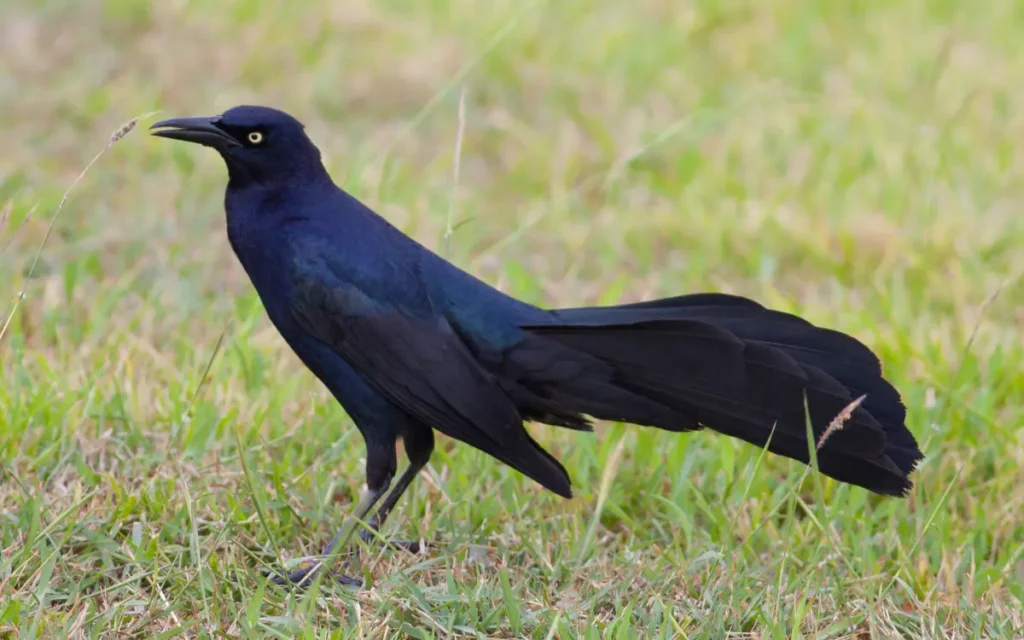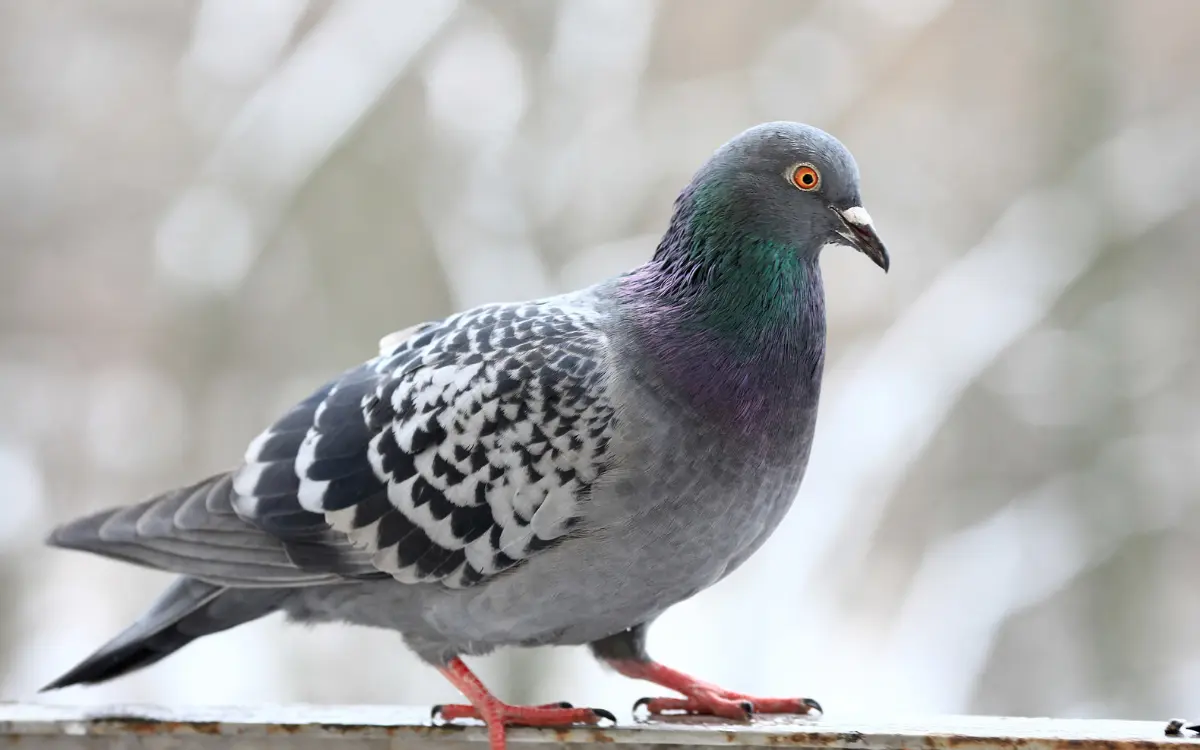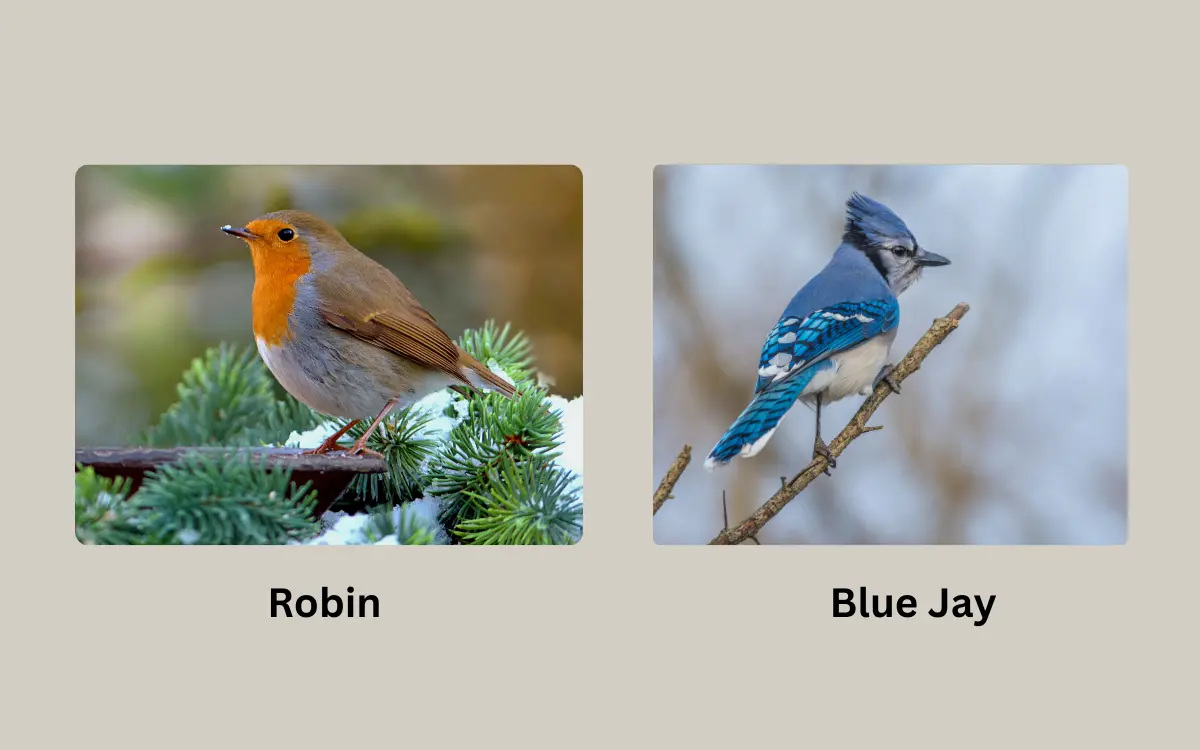Common Grackle vs Great tailed Grackle: Key Differences Explained
If you’ve ever watched a noisy flock of glossy blackbirds take over a parking lot, you’ve probably encountered grackles. But were they Common Grackles or Great-tailed Grackles? These two birds are often confused because of their iridescent plumage, yellow eyes, and loud personalities.
While they may look alike at first glance, each species has its own distinct features, ranges, and behaviors. Knowing how to tell them apart can make your birdwatching more rewarding and help you better understand their fascinating adaptability. Let’s explore the key differences between the Common Grackle and the Great-tailed Grackle.
Common Grackle vs Great-tailed Grackle Comparison

| Feature | Common Grackle | Great-tailed Grackle |
| Size | 11–13 inches | 15–18 inches |
| Tail | Long, keel-shaped | Very long, V-shaped, dramatic in flight |
| Plumage | Iridescent purple, green, or blue sheen | Glossy black with strong purple-blue highlights |
| Eyes | Yellow | Yellow |
| Range | Eastern & central U.S., parts of Canada | Southwest U.S., Texas, Mexico, Central America |
| Voice | Harsh, metallic creaks | Loud whistles, squeaks, and varied calls |
Physical Appearance
Common Grackle

The Common Grackle is a medium-sized blackbird with a glossy, iridescent sheen. Depending on the light, you may see shades of purple, blue, or green across its body. Its tail is long and keel-shaped, tapering into a point when spread. Males are larger and glossier, while females are slightly smaller and more subdued in color.
Great-tailed Grackle
The Great-tailed Grackle is noticeably bigger, especially the males, which can measure up to 18 inches long. Its most striking feature is its enormous V-shaped tail, which it fans out in flight like a rudder. Males are sleek, glossy, and almost theatrical with their shimmering plumage. Females look very different—brown overall with a lighter underside and shorter tails, making them easier to distinguish from Common Grackles.
Range and Habitat
Common Grackle
- Found mostly in the eastern and central United States, as well as southern Canada.
- Prefers open fields, woodlands, agricultural land, and suburban backyards.
- A year-round resident in much of its range.
Great-tailed Grackle
- Native to Mexico and Central America, but has expanded northward into the Southwestern United States, Texas, and as far as Kansas.
- Frequently spotted in cities, wetlands, agricultural fields, and along coasts.
- Known for thriving in urban environments, where they boldly forage around humans.
Behavior and Diet
Common Grackle
Common Grackles are omnivores with a varied diet. They eat:
- Seeds and grains (especially corn, which makes them unpopular with farmers).
- Insects and invertebrates.
- Small animals such as frogs and lizards.
- Berries and fruits.
They often forage on the ground, walking with a distinct strut. In flocks, they can strip a field of crops or dominate backyard feeders.

Great-tailed Grackle
Great-tailed Grackles are even more opportunistic and are often described as “urban survivors.” They feed on:
- Insects and grubs.
- Fruits and grains.
- Fish, frogs, and eggs.
- Human food scraps from trash cans and outdoor dining areas.
They are highly adaptable and aggressive feeders, frequently seen in large, noisy groups around shopping centers or city parks.
Songs and Calls
Common Grackle
The Common Grackle’s call is often described as harsh, metallic, and squeaky. They lack musicality, instead producing a series of sharp notes and creaking sounds.
Great-tailed Grackle
The Great-tailed Grackle has a much wider vocal range. Its calls include:
- Whistles
- Squawks
- Clicks
- High-pitched squeals
These vocalizations can carry long distances, making them one of the loudest and most noticeable birds in urban settings.
Male vs Female Differences
Common Grackle
- Males are larger, darker, and more iridescent.
- Females are smaller with duller coloration but still share the yellow eyes and keel-shaped tail.
Great-tailed Grackle
- Males are glossy black, long-tailed, and significantly larger.
- Females are brown and tan with much shorter tails, making them look almost like a different species altogether.
Tips for Birdwatchers – How to Tell Them Apart
- Size: If the bird looks especially large, it’s likely a Great-tailed Grackle.
- Tail shape: Common Grackles have keel-shaped tails; Great-taileds have extravagant, V-shaped tails.
- Location: Eastern U.S. = Common Grackle. Southwestern states and Texas = Great-tailed Grackle.
- Voice: Common Grackles sound metallic and creaky, while Great-tailed Grackles are loud, varied, and musical in their own quirky way.
- Female plumage: Female Great-taileds are brownish; female Common Grackles are just duller versions of the male.
Read also: Robin vs Blue Jay:Differences
Frequently Asked Questions
Are Common and Great-tailed Grackles related?
Yes. Both belong to the blackbird family (Icteridae). While they share many traits, they evolved separately and occupy different ranges.
Which grackle is more urban?
The Great-tailed Grackle has become a city bird in the Southwest, commonly found in parking lots and outdoor dining areas. Common Grackles are seen in suburban neighborhoods but are less tied to human food.
Do both species migrate?
Common Grackles migrate in northern parts of their range but stay year-round in warmer areas. Great-tailed Grackles are mostly non-migratory, though they may move locally.
Which bird is louder?
The Great-tailed Grackle is by far the noisier bird, with a wide variety of squeals and whistles that dominate urban soundscapes.
Are grackles considered pests?
Yes, in some areas. Common Grackles damage crops, while Great-tailed Grackles can be noisy, messy, and aggressive around people. However, both play ecological roles by controlling insect populations.






